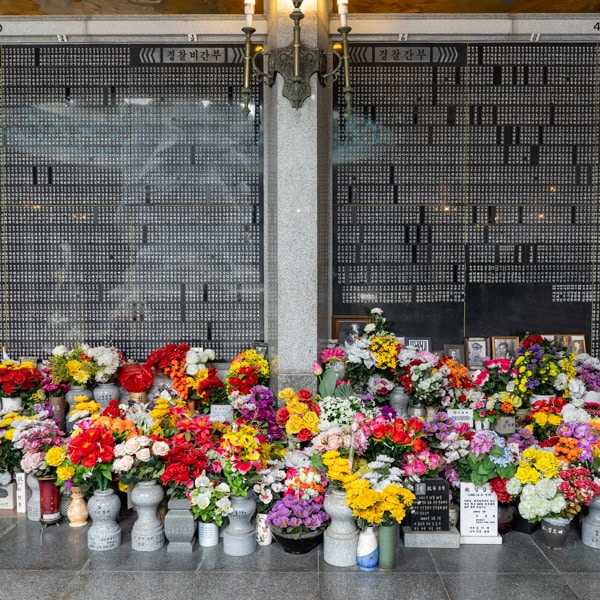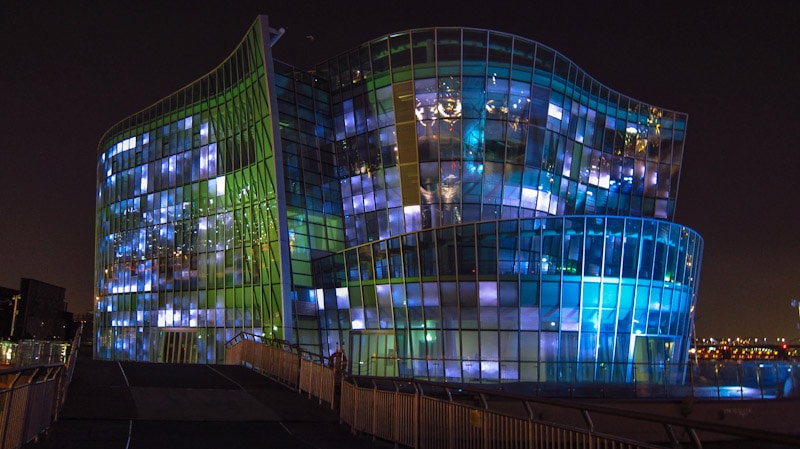
Seoul National Cemetery, located on the Hangang River in Dongjak-dong, is the final resting place of thousands of fallen Korean patriots. Also known as the Nation’s Sanctuary, over 175,000 veterans, soldiers, students, policemen, army reservists, and independence fighters who fought for their freedom against Imperial Japan are buried within these hallowed grounds. Each and every one of these patriots made the ultimate sacrifice for the defense, security, development of their country.
The cemetery is also the final resting place of four of Korea’s past presidents: Rhee Syng-man, the Republic of Korea’s first president, Park Chung-hee, a dictator who also turned the country around economically, Kim Young-sam, a pro-democracy activist, and Kim Dae-jung, a Nobel Peace Prize winner.
When established by Syngman Rhee in 1956, Seoul National Cemetery was the only national cemetery. By the 1970s, Seoul National Cemetery reached its capacity leading to the construction of Daejeon National Cemetery.
What to see at Seoul National Cemetery
Chungseong Fountain
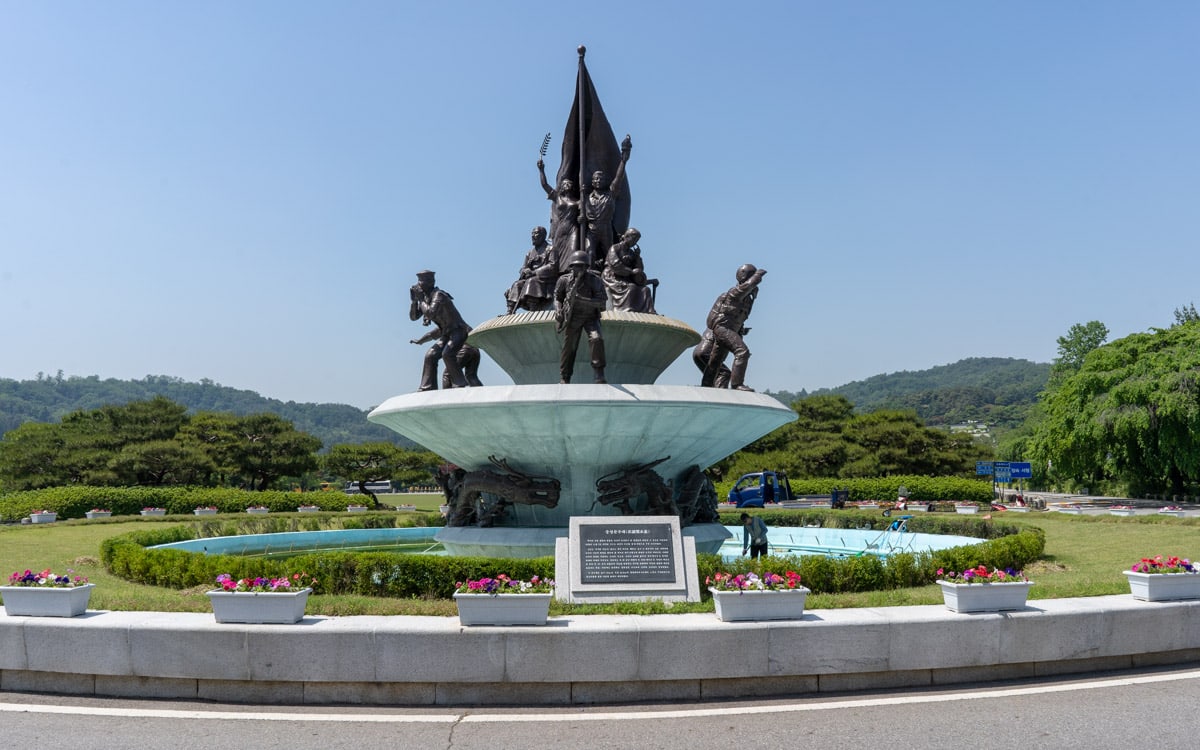
Near the front gate of Seoul National Cemetery is the Chungseong Fountain. This fountain symbolizes both the spirt and achievements of patriots who sacrificed their lives for the peace and prosperity of the country. Near the top of the fountain are two statues, both male and female, holding laurel leaves. These figures represent a free and peaceful country. The two seated figures of older citizens represents the people of Korea and their drive for the prosperity and the development of the country. The statues on the lowest level symbolize the armed forces, police officers, and reservists who fought and protected the nation.
Memorial Gate

This is the Memorial Gate of Seoul National Cemetery. The design of the gate was inspired by the shrines and halls built during the Goryeo dynasty (918–1392) and the Joseon dynasty (1392–1897). Statues of seated tigers can be found on each side of the gate. These statues symbolize the protection of the souls of patriots who sacrificed their lives to the motherland. Special events such as the honor guard demonstration and military music honor guard demonstration take place here.
Memorial Tower

Located just past the Memorial Gate is the Memorial Tower, an important symbol of Seoul National Cemetery, the Nation’s Sanctuary. The Memorial Tower is dedicated to the heroes and patriots who sacrificed their lives for the country.
The Memorial Tower is 31 meters (101 feet) tall. On both sides of the tower are stone walls representing a folding screen used during sacrificial offerings at ancestral rites.
At the far end of the stone wall to the left of the tower is the Patriots Memorials. This memorial, which depicts five freedom fighters, honors patriots who fought for independence against Japan. At the far end of the stone wall to the right of the tower is the War Heroes Memorial. This memorial, which depicts five fallen soldiers, policemen and others, honors those died protecting their country.
Inside Memorial Tower is the Memorial Tablet Enshrinement Hall. This hall houses the memorial tablets of 104,000 solders whose remains were never found. The hall also holds the remains of 7,000 unknown soldiers who died during the Korean War. Their remains are enshrined below the Ascension of the Souls statue.
Altar to Patriots and Patriotic Martyrs

The Altar to Patriots and Patriotic Martyrs, also known as the Altar to Heirless Patriots, contains the tablets of 131 patriots, independence fighters of the Korean Provisional Government, and heirless patriots who are known only by their names.
At the center of the altar is a granite sculpture of a dragon flanked on both sides by 2.12 meter (6.9 foot) guardian god statues. A black stone tablet on the front of the altar reads “Spirit of the Nation.” On the back side of the alter is an engraved poem written by Lee Eun-sang.
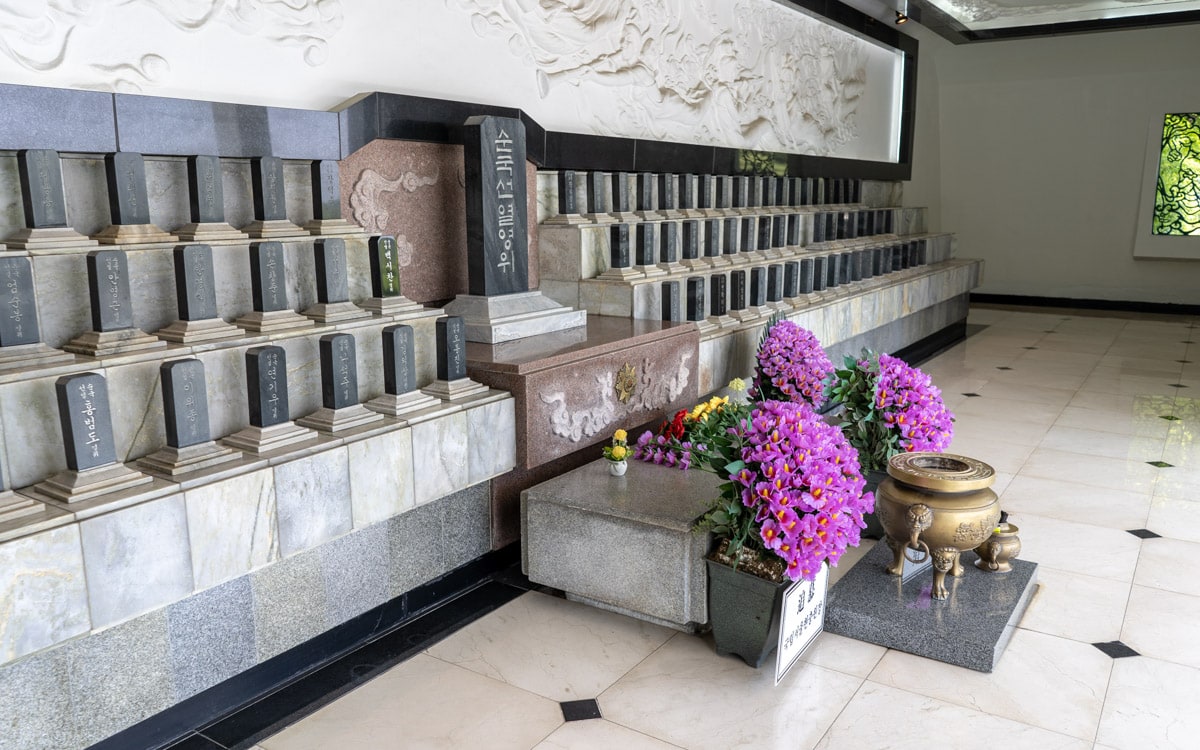
Enshrined inside the alter are the tablets of patriots who sacrificed their lives during the late Joseon dynasty, during the March 1st Korean Independence Movement, against Imperial Japan, and during the enlightenment movement.
Graveyard for Casualties of War
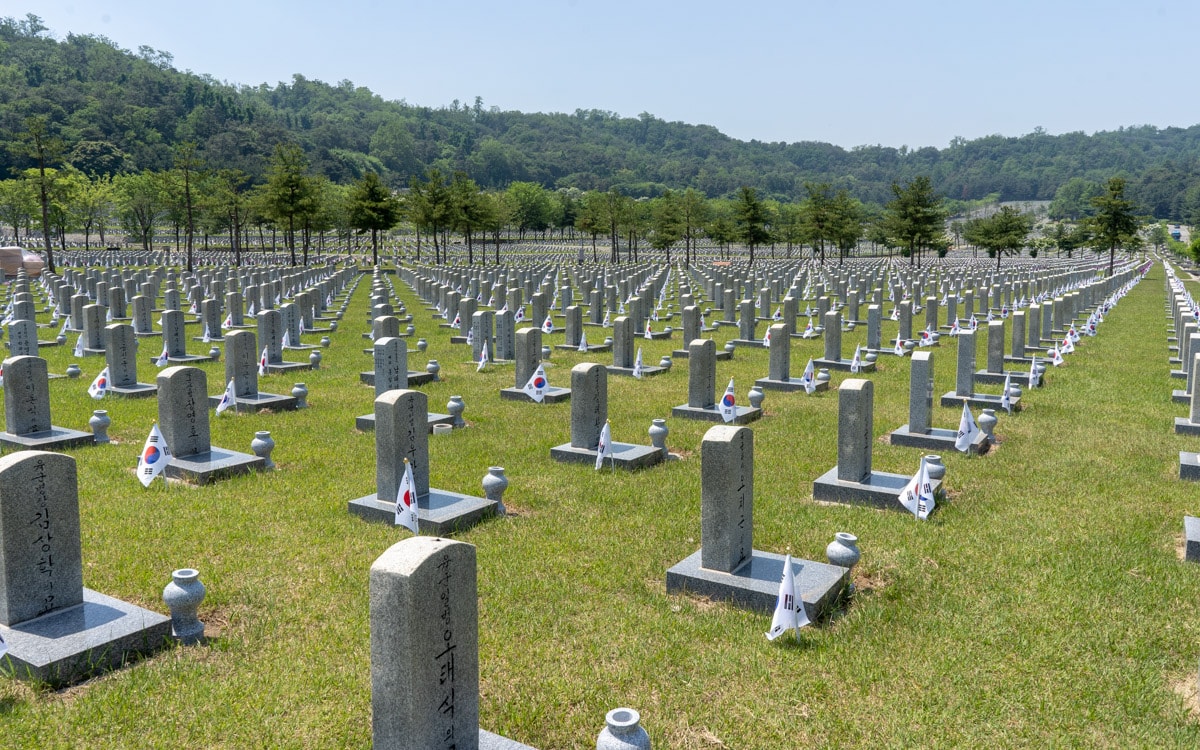
The Graveyard for Casualties of War is the largest graveyard found at Seoul National Cemetery. This graveyard is final resting spot of 54,000 soldiers, student army volunteers, military civilians, and police officers who were killed in action during the Korean War, Vietnam War, counterintelligence operations, and other battles. The endless rows of gravestones is a reminder of how many patriots sacrificed their lives for their country.
Memorial to the Unknown Soldiers of the Korean Independence Army
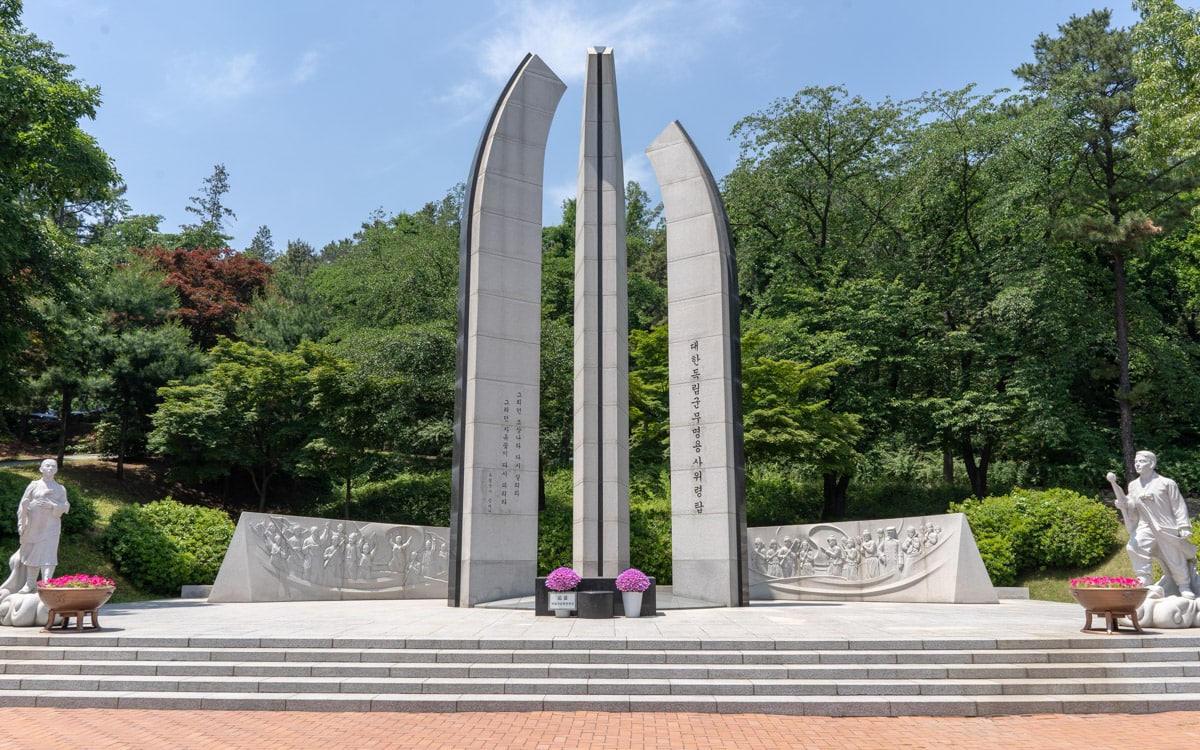
During the Korean War, Korean Independence Army fighters engaged in fierce resistance against Imperial Japan from bases in Manchuria (eastern China) and Siberia (Russia). Many of these fighters who died were never identified.
On May 17, 2002, the Memorial to the Unknown Soldiers of the Korean Independence Army was unveiled. This memorial honors unknown soldiers of the Korean Independence Army who sacrificed their lives for the independence of Korea from Imperial Japan.
The monument, located on a five-tiered platform, features three columns. These columns depict independent fighters discussing their plans with their heads together. The column on the right is 12 meters (39.3 feet) tall, symbolizing the 12 months of the year and the passing of time. The other columns are 14 meters (45.9 feet) and 16 meters (52.4 feet) tall.
Memorial to the Unknown Student Volunteer Soldiers
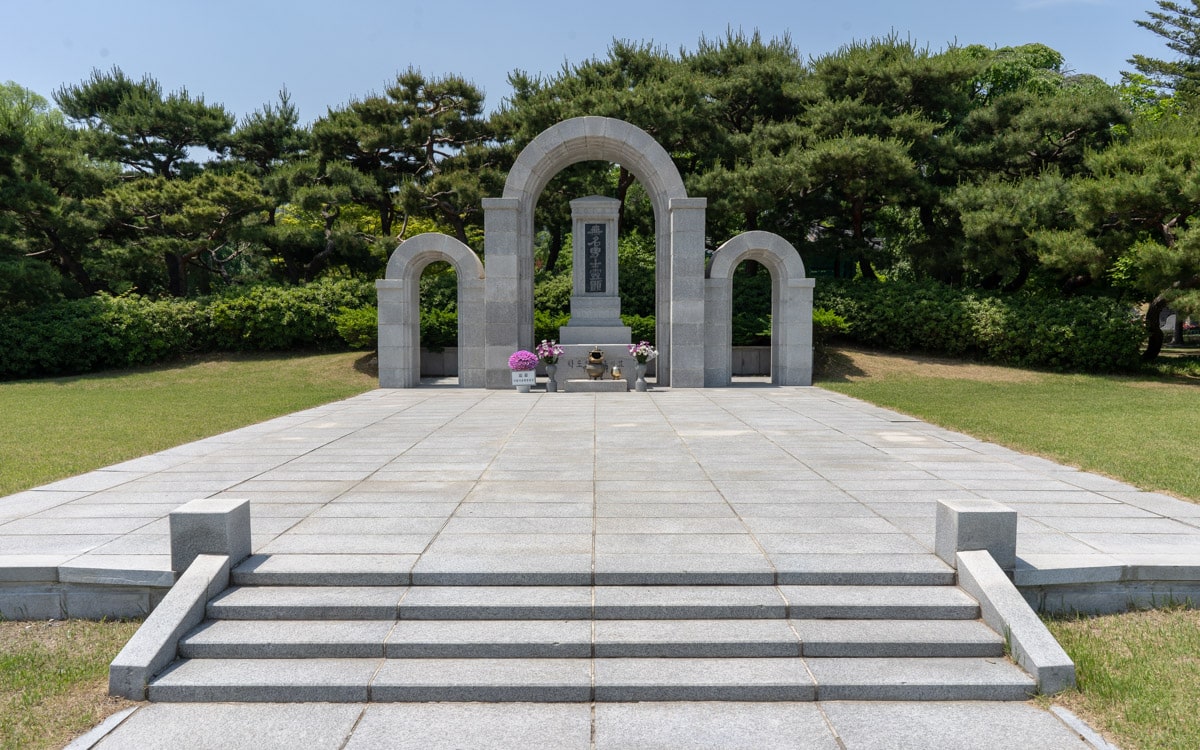
During the Korean War, over 50,000 students joined the war and volunteered to fight for their country. As they weren’t soldiers, these students often fought in their school uniforms and without any military serial numbers to identify them. Over 7,000 of these students died during the war. Of those who died, the identities of 48 students remains unknown. Their remains are buried here in a hemispherical stone grave located behind the Memorial to the Unknown Student Volunteer Soldiers.
The memorial features three arches. The center arch, the largest, is 3.6 meters (11.8 feet) high and 8 meters (26.2 feet) wide. The arches on the left and right are both 3 meters (9.8 feet) high. On the front, an inscription reads “To the souls of the unknown soldiers.” On the back, another inscription reads, “The Korean unknown soldiers, the glory of the people, rest in peace here. July 15, 1955, the Republic of Korea.”
Graveyard for Generals
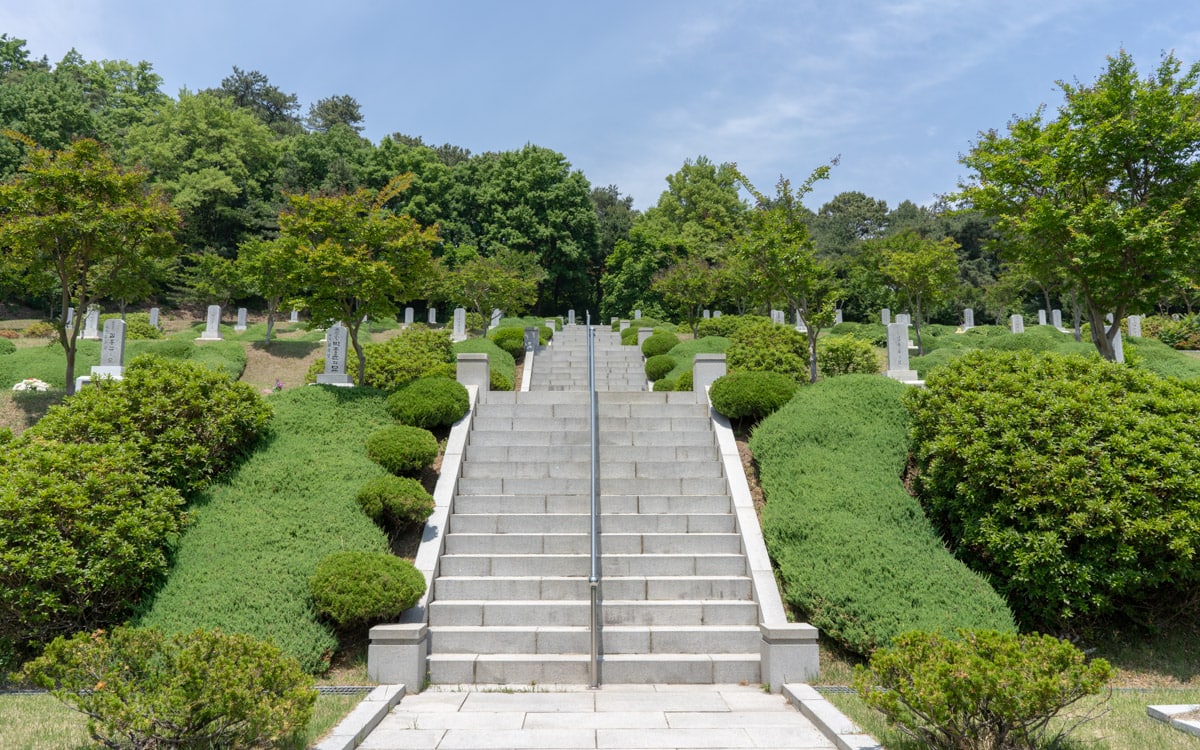
This is the Graveyard for Generals. Found in this graveyard are 356 generals who contributed to the establishment and development of the military after the liberation of Korea. This graveyard is also for those generals who fought in the Korean War and other counterespionage operations. Among them is General Kim Jong-o who was the 15th Chief of Staff of the Army and led the 9th Division to victory in the Battle of White Horse Mountain. Also laid to rest here is Admiral Son Won-il who was the Chief of Naval Operations and was part of the Incheon Landing Operation during the Korean War. Also buried here is General Choi Yong-deok who was the 2nd Chief of Staff of the Air Force.
Graveyard for Meritorious Citizens

While most buried at Seoul National Cemetery are veterans and soldiers, there are a few citizens who have the honor of being buried at the Nation’s Sanctuary. Buried inside the Graveyard for Meritorious Citizens are 71 deserving citizens who devoted their lives to the prosperity and development of their country. Two of the meritorious citizens buried here are Lee Beom-seok (1900–1972) and Ju Si-gyeong (1876-1914). Lee was a Korean independence activist and later the first Prime Minister of South Korea from 1948 to 1950. Ju was one of the founders of modern Korean linguistics and established the Korean Language System Society. Also buried here are 17 members of a diplomatic mission to Myanmar. These members were killed by an explosion on October 9, 1983 in Rangoon when North Koreans attempted to assassinate Chun Doo-hwan, the fifth president of the Republic of Korea.
Graveyard for Foreigners
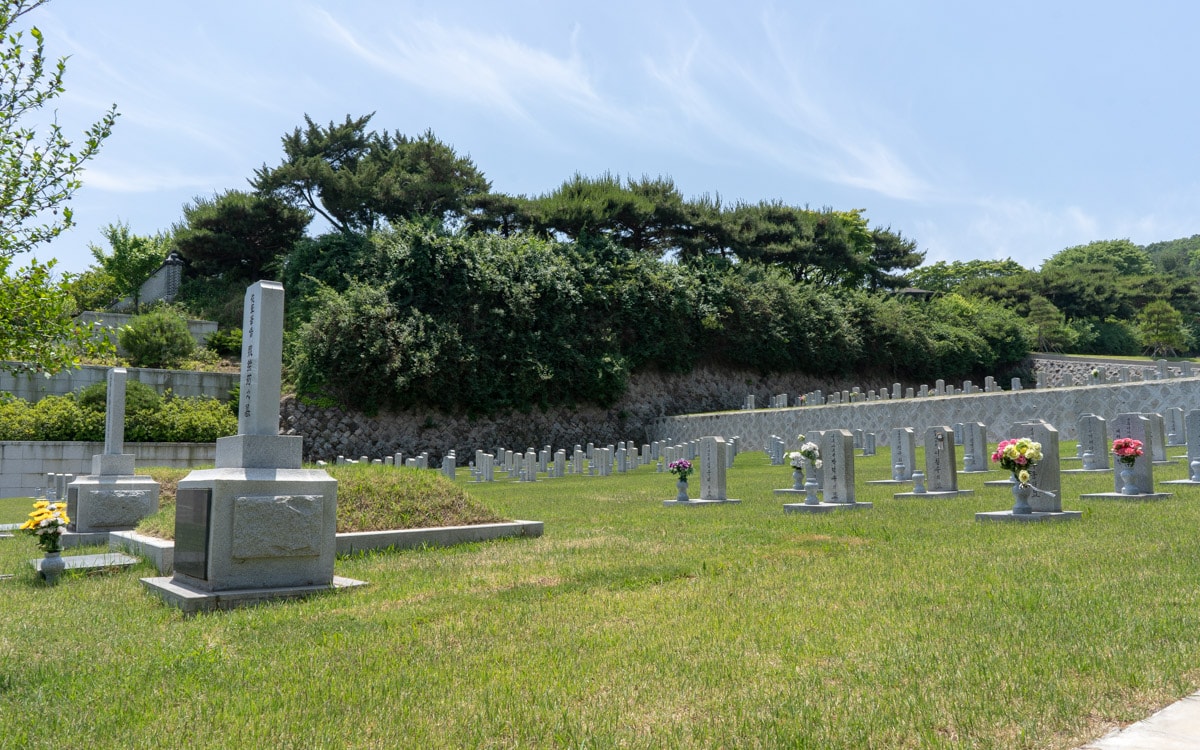
There are currently three foreigners buried at Seoul National Cemetery at the Graveyard for Foreigners. This small graveyard was established on May 15, 2012. These three citizens are Jiang Hui Lin (1925-1951), Wei Xu Fang (1923-1989), and Dr. Frank W. Schofield (1889-1970).
Lin, a Chinese citizen living in Pyeongyang, was part of the 15th Regiment of the 1st Division. He died in February, 1951 while observing and interrogating enemies. He was buried at the cemetery in 1964 and his remains were moved to this graveyard in 2012.
Fang, also a Chinese citizen, was awarded the Hwarang Order of Military Merit for his duty during the Korean War. After the war, Fang contributed to society by rendering free medical treatment along with providing scholarships to those in need. Fang died in 1989 and was buried at the cemetery.
Dr. Frank W. Schofield was an English-Canadian professor who taught at Yonsei University in 1916. In 1919, Schofield supported and documented the March 1st Korean Independence Movement. His photographs from demonstrations at Pagoda Park and Jeam-ri Church made the world aware of the atrocities of Imperial Japan. In 1968, Schofield was awarded the Order of Merit for National Foundation and the Independence Medal. In 1970, Schofield was buried at Seoul National Cemetery.
Gravesite of President Rhee Syng-man and His Wife

This is the gravesite of President Rhee Syng-man and his wife. Rhee served as the 1st President of the Republic of Korea from 1948 to 1960. He was born on March 26, 1875 in Daegyeong, a village in Pyongsan County in present day North Korea.
Following the March 1st Movement in 1919, in which Korean activists resisted the occupation of Korea by Japan, Rhee was appointed as the 1st President of the Provisional Government of the Republic of Korea. This Korean government-in-exile was based in Shanghai, China. For the next six years, Rhee campaigned for independence. After Rhee was impeached in 1925, he moved to the United States and continued his campaign. After the surrender of Japan in 1945, Rhee returned to Korea where he was elected Speaker of the Assembly prior to being elected president of the newly established Republic of Korea in 1948.
As president, Rhee was anti-communist and pro-American. Along with communists, Rhee’s government jailed political opponents and suspected sympathizers. After years of corruption and political repression, Rhee was forced to resign on April 26, 1960 after mass protests. After he resigned, Rhee was exiled to Hawaii where he lived until his death on July 19, 1965. Rhee was buried at Seoul National Cemetery on July 27, 1965.
Gravesite of President Park Chung-hee and His Wife

This is the Gravesite of President Park Chung-hee and His Wife. Park served as the 5th to the 9th President of the Republic of Korea from 1962 to 1979. Park was born in Seonsan (present day Gumi) on November 14, 1917.
Amid political chaos, Park rose to power during a military coup on May 16, 1961. Park became president on March 24, 1962 after the resignation of President Yun Posun. During his presidency, Park established economic policies which allowed rapid economic growth that led to the industrialization of Korea. This period of rapid growth was known as the Miracle on the Hangang River. While Korea became a fast growing nation, over time, Park’s popularity began to decline. This was due to Park’s authoritarian rule, undemocratic policies, and human rights abuses.
Park was assassinated by Kim Jae-gyu on October 26, 1979. Kim was both Park’s friend and director of the Korean Central Intelligence Agency. Park was buried at Seoul National Cemetery on November 3, 1979.
Gravesite of President Kim Young-sam

This is the gravesite of President Kim Young-sam who served as the 14th President of the Republic of Korea from 1993 to 1998. Kim was born on December 20, 1927 on Geojedo, an island located at the southeastern tip of the Korean peninsula.
In 1954, Kim was elected as the youngest member of the 3rd National Assembly of the Republic of Korea. Over the next decades, Kim became a political icon and one of the leaders of opposition against the authoritarian regime of Park Chung-hee. When elected president in 1992, Kim was the first civilian to hold the office in 32 years. He continued to use his position as president to fight for democracy and against corruption while globalizing his country.
After his presidency ended, Kim continued work as a pro-democracy activist and spoke at many events promoting democracy. Kim Young-sam died on November 22, 2015 and was buried at Seoul National Cemetery on November 26, 2015.
Gravesite of President Kim Dae-jung
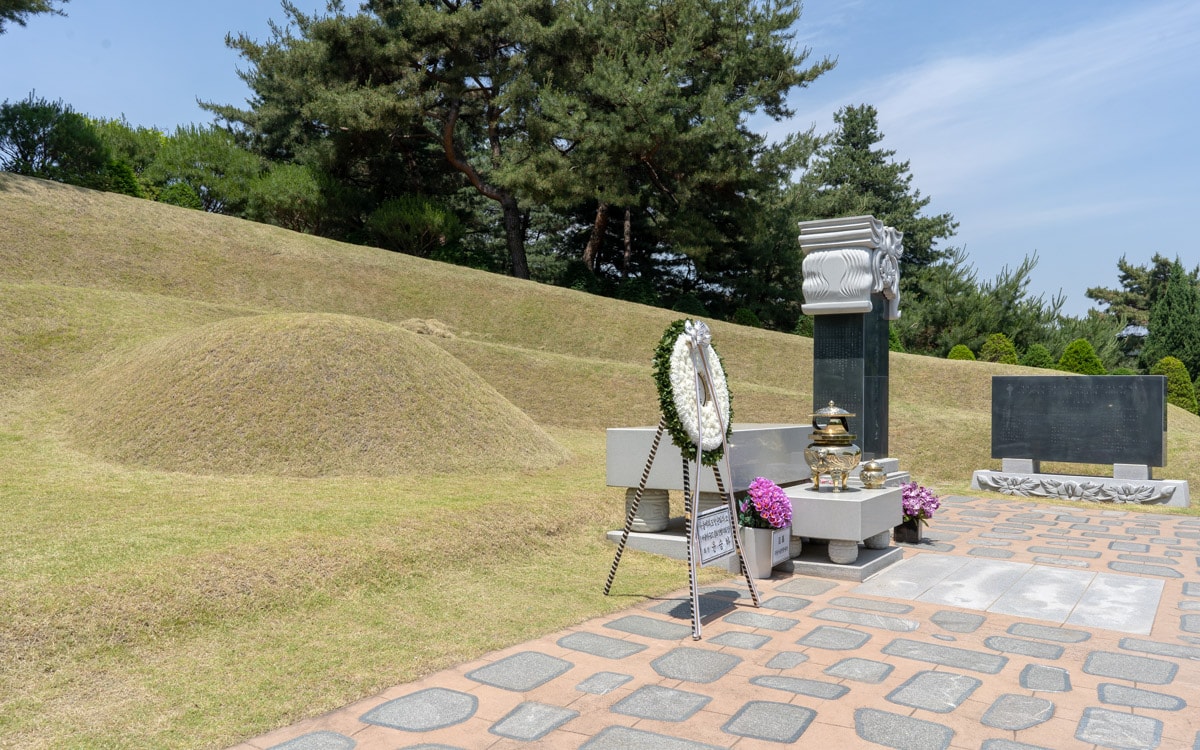
This is the gravesite of President Kim Dae-jung who served as the 15th President of the Republic of Korea from 1998 to 2003. Kim was born on January 6, 1924 on Hauido, an island located at the southwestern tip of the Korean peninsula.
Kim was elected as a representative for the National Assembly on May 14, 1961. Two days later, Park Chung-hee came to power in the May 16 coup. Park used his dictatorial powers to void the elections. Kim went on to win a seat in the National Assembly in 1963 and 1967. In 1971, Kim unsuccessfully ran for president as an opposition candidate. After criticizing President Park, Kim was kidnapped and nearly killed, forcing himself to exile to the United States. After Park’s assassination in 1979, Kim returned to Seoul where he continued his political career.
Kim was sworn in as president on February 25, 1998. During his presidency, Kim established polices which brought about economic recovery and oversaw South Korea as an important global player. In 2000, Kim was awarded the Nobel Peace Prize for his work for democracy, human rights, and for peace with North Korea. Kim died on August 18, 2009 and was buried at Seoul National Cemetery on August 23, 2009.
Graveyard of Lady Changbin An
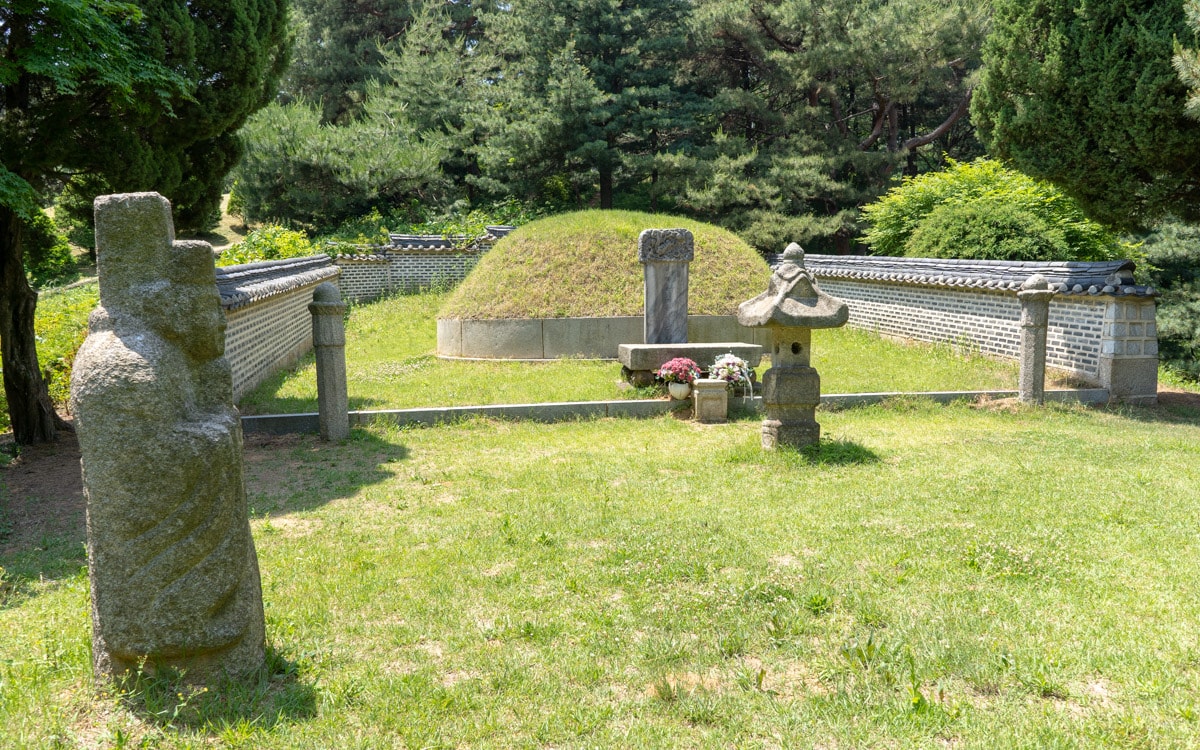
This is the Graveyard of Lady Changbin An (1499–1549). Changbin An was a concubine of King Jungjong (1488-1544), the eleventh king of the Joseon dynasty who reigned from 1506 to 1544. She was also the grandmother of King Seonjo (1552-1608), the fourteenth king of the Joseon dynasty who reigned from 1567 to 1608. In 1507, at the age of 9, Changbin An entered the royal court. At the age of 22, she became a court lady and at the age of 31 she was promoted in rank to Sugwon. Changbin An had two sons and a daughter. Her second son, Deokheung Daewongun, was the father of King Seonjo.
In 1550, Changbin An’s tomb was built in Gyeonggi-do. The grave was moved to this location the following year. The tomb features a grave post, stone table, stone lantern, and stone statues. In 1684, a Sindobi stele was erected at the graveyard. For a court lady, this was rare but allowed since her offspring succeeded to the throne. This important cultural property shows what the graveyard of a Joseon dynasty court lady looked like. In 1577, she was posthumously granted the title of Lady Changbin An.
Ten Human Bombs Memorial

On May 3, 1949, one year before the start of the Korean War, a North Korean army unit ambushed a South Korean army unit on a hill near Kaesong, northwest of Seoul. The following day, ten South Korean soldiers carrying bombs retook the strategically important hill by surprising their enemy and detonating their explosives. Their heroic act not only took out the enemy, but themselves. The Ten Human Bombs Memorial was erected in honor of their sacrifice.
Construction on the Ten Human Bombs Memorial was completed in April, 1955. It was unveiled to the public on May 4, 1955, the sixth anniversary of the incident. The five level memorial stands 6 meters (19.6 feet) tall. An epitaph is engraved with the names and ranks of all soldiers involved. In English, near the top of the memorial, is an inscription reading “THE TEN BRAVE WARRIORS.”
Memorial to Patriot Police Officers
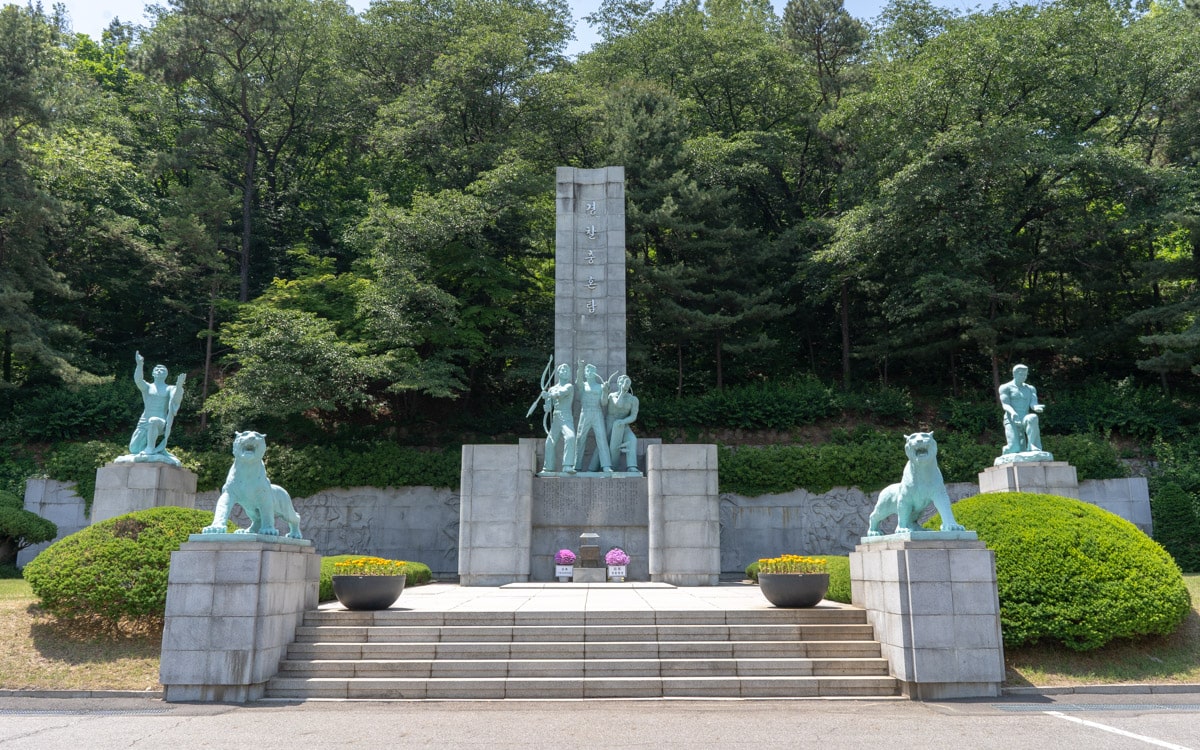
This is the Memorial to Patriot Police Officers. It is dedicated to the 814 police officers who sacrificed their lives to protect their country during the outbreak of the Korean War. It is also dedicated to the officers who devoted their lives towards the protection of life and the maintenance of property after the liberation of Korea. The monument symbolizes the spirit of public service and the caring, loyal spirt of democratic police officers.
Charnel House

By the 1970s, Seoul National Cemetery was reaching its capacity. While Daejeon National Cemetery was opened, more space was needed at Seoul National Cemetery. On March 1, 2006, the Charnel House was opened for the inurnment of cremated remains. The Charnel House can hold up to 24,000 cinerary urns. On the outside of the house is a large stone relief which depicts soldiers, officers, citizens, children, and even a relief of Gwanghwamun Square in central Seoul.
Hogukjong (Defense Bell of the Motherland)

Housed inside this hexagonal pavilion is Hogukjong, also known as the Defense Bell of the Motherland. This bell was created in 1973 with funding from the Korean Veterans Association (KVA) to honor the heroes who scarified their lives for the motherland. The bell, which weighs two tons, measures in at 1.74 meters (5.7 feet) tall and 1.22 meters (4 feet) in diameter. During the annual Memorial Ceremony of the Korean War, hosted by the KVA, the bell is struck 22 times symbolizing the 22 countries that took part in the Korean War.
Seoul National Cemetery Information
Hours
Open daily 6:00-18:00Admission
Free
Address
210 Hyeonchung-ro, Dongjak-gu, Seoul, South Korea
GPS Coordinates: 37.50058, 126.97262
How to Get Here
Exit 8 of Dongjak Station (Seoul Subway Line 4 and Seoul Subway Line Line 9).Map
Additional Resources
Klook
Klook offers discounted tickets and reservations for various attractions and services in Seoul, from theme parks and museums to tours and transportation options.
Viator by TripAdvisor
Viator is a popular online platform that helps travelers book tours, activities, and unique experiences worldwide, including in Seoul. It connects users with a wide selection of options – from sightseeing tours to cultural events and outdoor adventures – all offered by local providers.
Rakuten
Save money while exploring Seoul with Rakuten's cashback program. Book your hotels or other services through Rakuten and enjoy cashback rewards and exclusive deals.
If you sign up using the link below, you could earn $30 cashback on your first purchase over $30.
Book Recommendations
For an immersive guide to Seoul, many travelers choose to bring a book along. Fodor's Seoul, for example, offers detailed recommendations on sights, restaurants, maps, and travel tips.
Nearby Sights
Seorae Maeul (Seorae French Village)

Seorae Maeul (Seorae French Village), or French Town, is a small French neighborhood in Banpo-dong, Seocho-gu home to over 500 French and European expats. Over 40% of the French population in Seoul, most who are in the country for business, lives in this small and unique area. Many of the street signs found here are both in Korean, French, and English which adds to the charm of the area.
Banpo Hangang Park

Banpo Hangang Park is a park located on the southern side of the Hangang River. Most people visit this park to see the Banpo Bridge Rainbow Fountain show. The bridge is a well known tourist attraction and the longest fountain bridge in the world. The bridge measures in at 1,140 meters (3,740 feet).
Yongsan Family Park

Once a golf course for the United States military, Yongsan Family Park has become an oasis and a peaceful escape from the hustle and bustle of the city. The large park, which features wonderful wide open green spaces and trees, is situated right next to the National Museum of Korea just south of Mt.
Banpo Bridge (Moonlight Rainbow Fountain)
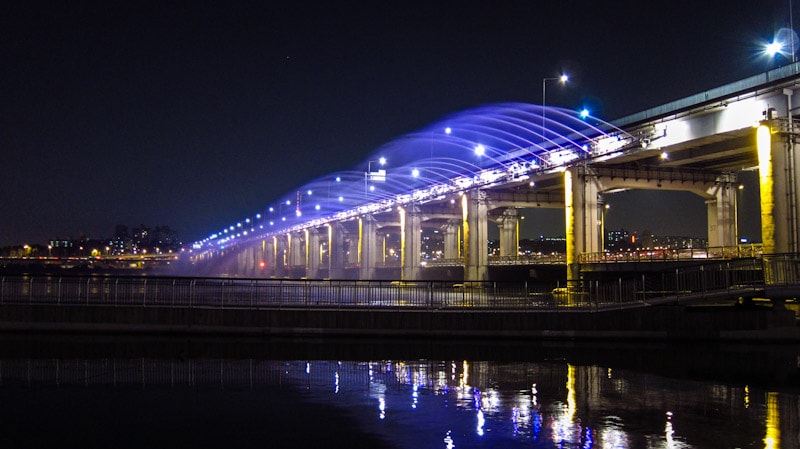
Banpo Bridge, the location of the Moonlight Rainbow Show, is a girder bridge that spans the Hangang River connecting the districts of Seocho and Yongsan. Construction on the double decker bridge was completed in 1982. The real reason people come here is to see the falling and dancing water, lights, and music of the Moonlight Rainbow Fountain show.
National Museum of Korea
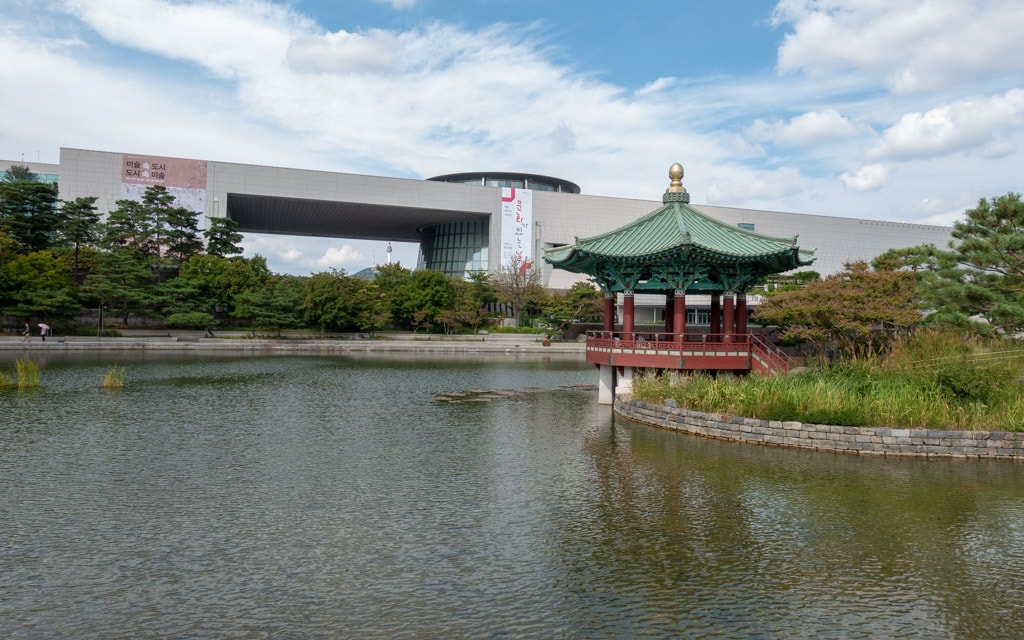
The National Museum of Korea is the largest museum in Korea. It showcases important cultural assets of Korea from prehistoric times through modern day. The museum opened on October 28, 2005 on the grounds of Yongsan Family Park. Many of the pieces found at the National Museum Of Korea today were first located at the Imperial Household Museum at Changgyeonggung Palace.
.
Last Updated on Oct 21, 2023



